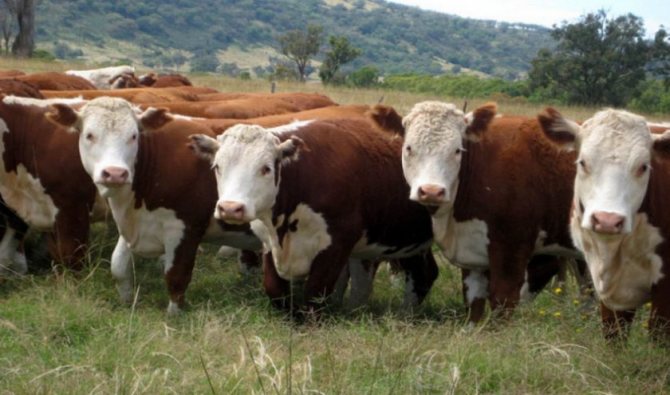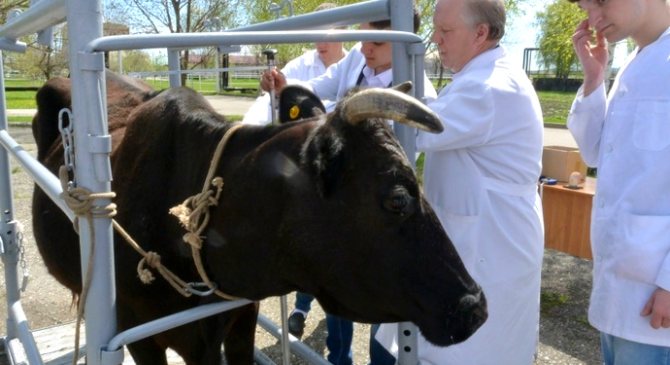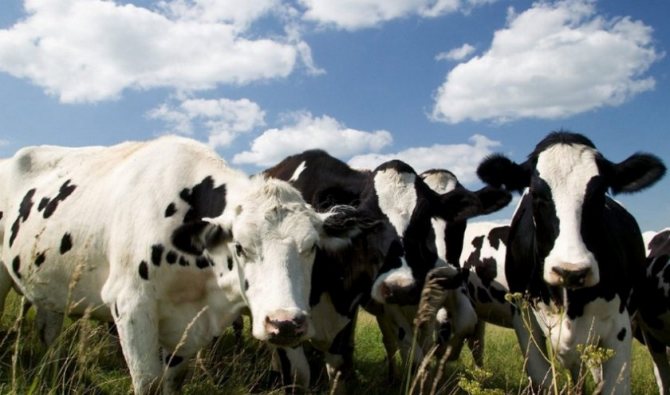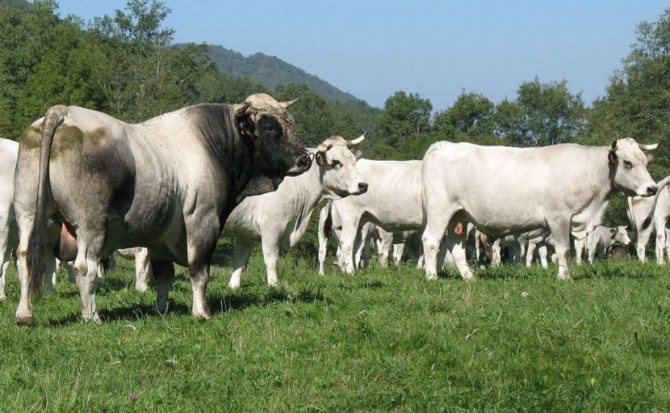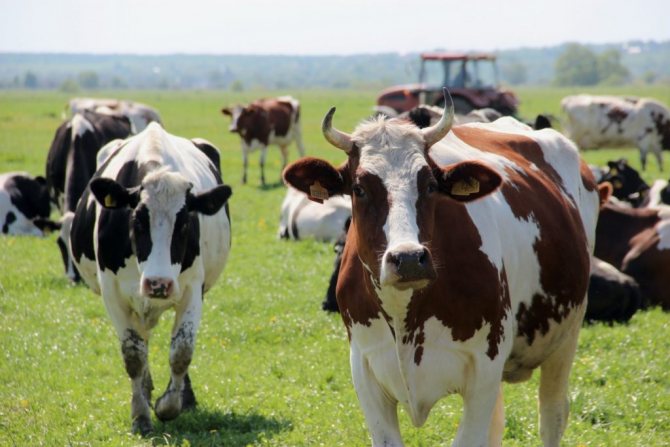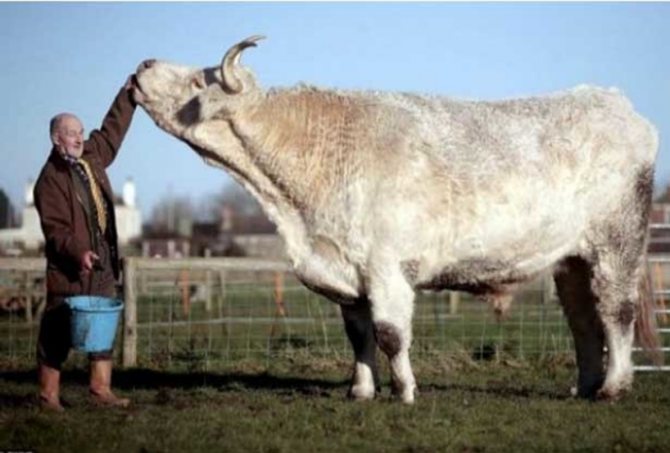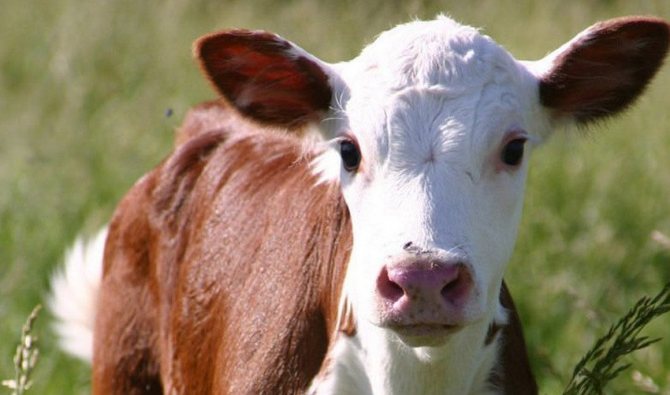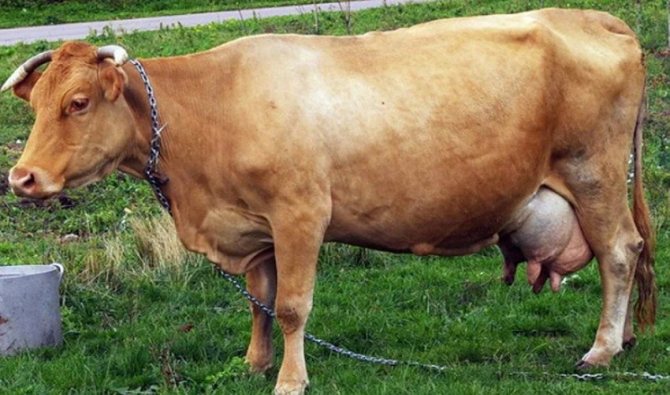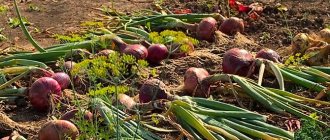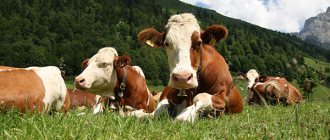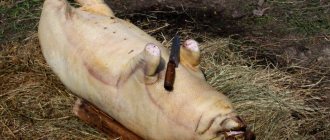Knowing how much a bull weighs is extremely helpful when buying cattle. By comparing the value of the mass of an animal with its age and breed, it is possible to timely identify a sick or lagging living creature and not be deceived. In addition, knowledge of the weight of the bull is also necessary when calculating the portion of feed needed to meet the physiological needs of the animal's body. Such a calculation will allow reaching the maximum indicators of livestock productivity in the future.

Measuring the weight of cattle
Cattle categories
All cattle can be divided into several age categories:
- the adult group, represented by heterosexual animals more than three years old, cows that have calved for the first time, whose weight at intake is less than 350 kg;
- females who calved for the first time, whose lifespan did not reach three years, but a pair of permanent incisors appeared. Here the receiving mass is more than 350 kg;
- young animals from 90 days to 3 years of age are represented by heterosexual individuals;
- young animals from 2 weeks to 90 days.
It all depends on the breed
The weight of an individual depends on the following criteria:
- sex - bulls are usually 350 kg larger than cows;
- age;
- breed.
In animal husbandry, there are several categories of cattle (Cattle) by weight category:
- selected - a bull or a cow weighs more than 450 kg;
- first grade - the weight of the animal reaches 450 kg;
- second grade - the mass is in the limit of 400 kg;
- the third grade is an animal weighing 300 kg.
An error of 30 kg for an adult is allowed. If the weight is very different from the average, then this indicates an unhealthy diet or the presence of diseases.
Also, the weight of the animal may depend on:
- climate;
- conditions of detention;
- diet.
If a person cannot influence the climate, then he can create favorable conditions for the breadwinners.
Be sure cows should be able to walk in the fresh air, but there are nuances here. So, long grazing is contraindicated for beef cows. They begin to lose their weight, the optimal solution is to keep them in the stall for a longer time. Dairy representatives, on the other hand, need long walks in the pasture.
Food should be balanced and of high quality. Be sure to feed the cattle:
- vegetable feed (these are juicy - silage, grass, fresh roots; rough - hay, straw and concentrated feed - grain, bran, cake);
- for animals - meat, fish and bone meal;
- compound feed and feed mixtures;
- vitamin and mineral supplements are added to food.
Cattle breeds are divided into 3 categories: dairy cows, meat and dairy cows or universal. The weight of these three types of livestock is different, some are larger, others are of much modest size. But both meat and dairy and universal cows have the weight mark where their productivity reaches its maximum.
Determination of the weight of livestock without scales
There are several ways to find out the average weight when fattening gobies for meat. Cattle is measured taking into account the following features:
- along the girth of the sternum - behind the scapular joints, taking the circle of the sternum as a guideline that runs in a vertical plane to the end of the scapula;
- along the oblique length of the body - the measurement is carried out, focusing on the beginning of the shoulder joint to the ischial tubercles (their posterior protrusion).
The data obtained are correlated with the table, from which the mass of livestock is recognized without the use of weight.


Indicators of the approximate live weight in heterosexual animals in kilograms
| Sternum circumference behind shoulder blades | Indicators of oblique body length | ||||||||||||||||
| 122 | 126 | 130 | 134 | 138 | 142 | 146 | 150 | 154 | 158 | 162 | 166 | 170 | 174 | 178 | 182 | 190 | |
| 136 | 194 | 202 | 206 | 213 | 220 | — | — | — | — | — | — | — | — | — | — | — | — |
| 140 | 210 | 218 | 223 | 231 | 236 | 244 | — | — | — | — | — | — | — | — | — | — | — |
| 144 | 222 | 230 | 236 | 243 | 250 | 258 | 266 | — | — | — | — | — | — | — | — | — | — |
| 148 | 235 | 244 | 250 | 259 | 265 | 274 | 282 | 289 | — | — | — | — | — | — | — | — | — |
| 152 | 247 | 255 | 262 | 270 | 278 | 287 | 296 | 303 | 311 | — | — | — | — | — | — | — | — |
| 156 | 260 | 270 | 277 | 287 | 295 | 304 | 313 | 320 | 329 | 337 | — | — | — | — | — | — | — |
| 160 | — | 286 | 292 | 300 | 307 | 317 | 327 | 334 | 345 | 352 | 362 | — | — | — | — | — | — |
| 164 | — | — | 306 | 317 | 325 | 334 | 345 | 354 | 364 | 372 | 382 | 391 | — | — | — | — | — |
| 168 | — | — | — | 333 | 341 | 351 | 364 | 373 | 383 | 391 | 404 | 413 | 422 | — | — | — | — |
| 172 | — | — | — | — | 356 | 368 | 379 | 388 | 399 | 409 | 419 | 429 | 440 | 450 | — | — | — |
| 176 | — | — | — | — | — | 386 | 399 | 408 | 420 | 429 | 441 | 452 | 463 | 474 | 484 | — | — |
| 180 | — | — | — | — | — | — | 418 | 428 | 443 | 450 | 464 | 475 | 486 | 497 | 508 | 520 | — |
| 184 | — | — | — | — | — | — | — | 445 | 458 | 468 | 481 | 493 | 503 | 516 | 528 | 540 | 551 |
| 188 | — | — | — | — | — | — | — | — | 480 | 490 | 504 | 516 | 529 | 541 | 553 | 567 | 576 |
| 192 | — | — | — | — | — | — | — | — | — | 509 | 523 | 536 | 549 | 563 | 574 | 589 | 599 |
| 196 | — | — | — | — | — | — | — | — | — | — | 547 | 561 | 574 | 587 | 600 | 612 | 627 |
| 200 | — | — | — | — | — | — | — | — | — | — | 583 | 597 | 610 | 624 | 640 | 652 | |
| 204 | — | — | — | — | — | — | — | — | — | — | — | — | 620 | 634 | 649 | 660 | 678 |
| 208 | — | — | — | — | — | — | — | — | — | — | — | — | — | -659 | 674 | 691 | 704 |
| 212 | — | — | — | — | — | — | — | — | — | — | — | — | — | — | 700 | 717 | 731 |
| 216 | — | — | — | — | — | — | — | — | — | — | — | — | — | — | — | 747 | 767 |
| 220 | — | — | — | — | — | — | — | — | — | — | — | — | — | — | — | — | 786 |
Young stock values
| girth of the sternum behind the shoulder blades | Oblique torso length parameters | ||||||||||||||||||
| 90 | 92 | 94 | 96 | 98 | 100 | 102 | 104 | 106 | 108 | 110 | 112 | 114 | 116 | 118 | 120 | 122 | 124 | 126 | |
| 84 | 54 | — | — | — | — | — | — | — | — | — | — | — | — | — | — | — | — | — | — |
| 86 | 57 | 58 | — | — | — | — | — | — | — | — | — | — | — | — | — | — | — | — | — |
| 88 | 59 | 60 | 61 | — | — | — | — | — | — | — | — | — | — | — | — | — | — | — | — |
| 90 | 63 | 64 | 65 | 67 | — | — | — | — | — | — | — | — | — | — | — | — | — | — | — |
| 92 | 67 | 68 | 69 | 70 | 72 | — | — | — | — | — | — | — | — | — | — | — | — | — | — |
| 94 | 70 | 71 | 73 | 74 | 75 | 76 | — | — | — | — | — | — | — | — | — | — | — | — | — |
| 96 | 73 | 75 | 76 | 77 | 78 | 79 | 81 | — | — | — | — | — | — | — | — | — | — | — | — |
| 98 | 77 | 78 | 80 | 81 | 82 | 83 | 84 | 86 | — | — | — | — | — | — | — | — | — | — | — |
| 100 | 80 | 82 | 84 | 85 | 86 | 87 | 88 | 90 | 91 | — | — | — | — | — | — | — | — | — | — |
| 102 | 84 | 85 | 86 | 88 | 89 | 91 | 92 | 93 | 95 | 96 | — | — | — | — | — | — | — | — | — |
| 104 | 88 | 90 | 91 | 92 | 94 | 95 | 97 | 98 | 99 | 101 | 102 | — | — | — | — | — | — | — | — |
| 106 | 93 | 95 | 96 | 98 | 99 | 100 | 102 | 103 | 104 | 106 | 107 | 109 | — | — | — | — | — | — | — |
| 108 | 99 | 100 | 102 | 103 | 105 | 106 | 107 | 109 | 110 | 112 | 113 | 114 | 116 | — | — | — | — | — | — |
| 110 | 105 | 106 | 107 | 108 | 110 | 112 | 114 | 116 | 117 | 119 | 120 | 121 | 123 | — | — | — | — | — | — |
| 112 | 110 | 11 | 112 | 114 | 115 | 117 | 118 | 119 | 121 | 122 | 124 | 126 | 128 | 130 | — | — | — | — | — |
| 114 | 115 | 117 | 118 | 119 | 121 | 122 | 124 | 125 | 126 | 128 | 129 | 131 | 132 | 133 | 135 | 136 | — | — | — |
| 116 | 121 | 122 | 124 | 125 | 126 | 128 | 129 | 131 | 132 | 133 | 135 | 136 | 138 | 139 | 140 | 142 | 143 | — | — |
| 118 | 123 | 124 | 126 | 127 | 129 | 131 | 132 | 134 | 135 | 137 | 139 | 140 | 142 | 143 | 145 | 147 | 148 | 150 | — |
| 120 | 129 | 130 | 132 | 133 | 135 | 137 | 138 | 140 | 141 | 143 | 145 | 146 | 148 | 149 | 151 | 153 | 154 | 156 | 157 |
| 122 | — | 135 | 136 | 138 | 139 | 141 | 142 | 143 | 145 | 146 | 148 | 150 | 151 | 153 | 155 | 157 | 159 | 160 | 162 |
| 124 | — | — | 142 | 144 | 145 | 147 | 148 | 150 | 152 | 153 | 155 | 156 | 158 | 160 | 161 | 163 | 164 | 166 | 168 |
| 126 | — | — | — | 150 | 152 | 153 | 155 | 156 | 158 | 161 | 163 | 164 | 166 | 168 | 169 | 171 | 172 | 173 | 174 |
| 128 | — | — | — | — | 158 | 160 | 161 | 163 | 164 | 166 | 168 | 169 | 171 | 172 | 174 | 176 | 177 | 179 | 180 |
| 130 | — | — | — | — | — | 166 | 168 | 169 | 170 | 172 | 174 | 176 | 177 | 179 | 180 | 182 | 184 | 185 | 187 |
When using tabular data, it is necessary to take into account that there is an error of 20 to 30 kg. These indicators will diverge from the result that is obtained using the balance to determine the mass. It should also be borne in mind that the weight of livestock varies depending on the age group, and in most cases this happens in jumps. Much depends on the diet, climatic zone, ailments and a number of other indicators.
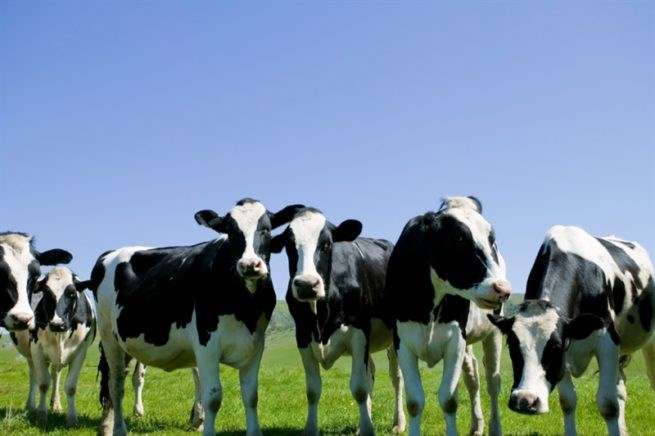

Due to the indicators already described, on average, fluctuations in weight can be observed per day, even if the usual content is used. They make up from 30 to 40 kg, or as a percentage it is 5-7. To determine a more accurate average live weight, all parameters must be taken correctly.
How much do a bull and a cow weigh?
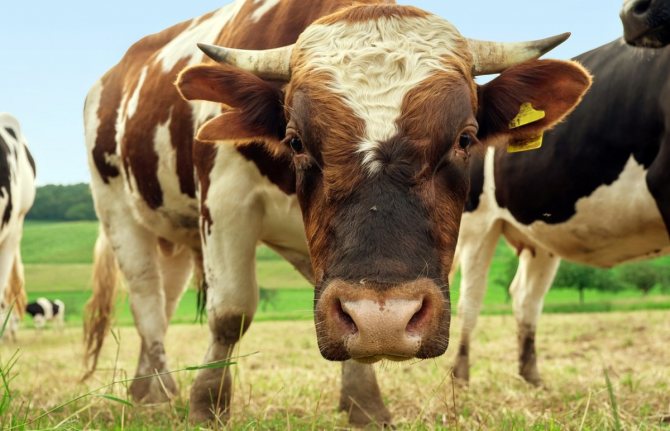

At birth, on average, the calf weighs a tenth of the mother's weight. Usually we are talking about 40 kilograms. Calves gain weight quickly.
The weight of a one-year-old bull is ten times more. This characteristic must be constantly monitored, because weight says a lot about the state of health.
Many livestock breeders raise bulls for no more than one year. During this time, the weight of the bull is approximately 400 to 500 kg. However, if you continue to fatten up to two years, the weight of the animal will reach one ton.
The bull's weight table by month is as follows:
- At birth - 40 kg.
- After 2 months. - from 60 to 80 kg.
- A three-month-old goby weighs 100 kg.
- At 6 months. - about 170 kg.
- By the end of the year, it is gaining 400 kg.
Turkhanovsky method
A special formula is applied here that can be used to determine mass in adult bulls. The following indicators are used for calculations:
- circumference of the sternum. The measurement is taken in the immediate vicinity of the forelimbs of the animal. For this, a special tape measure or centimeter is used;
- straight body length. Measure the distance from the beginning of the cervical spine to the tail. You can measure with a wooden stick with marked marks.
Calculate the mass using the formula below:
M = (A * B) / 100 * K, where
- M - weight in kilograms;
- K is the correction factor. The value is determined by the breed of animal which is being measured;
- A - the circumference of the sternum (in cm);
- B - straight body length (in cm);
The coefficient for the meat direction is 2.5;
For the milk direction - 2.
To get more accurate values, it is recommended to take into account the fat content of the bull.
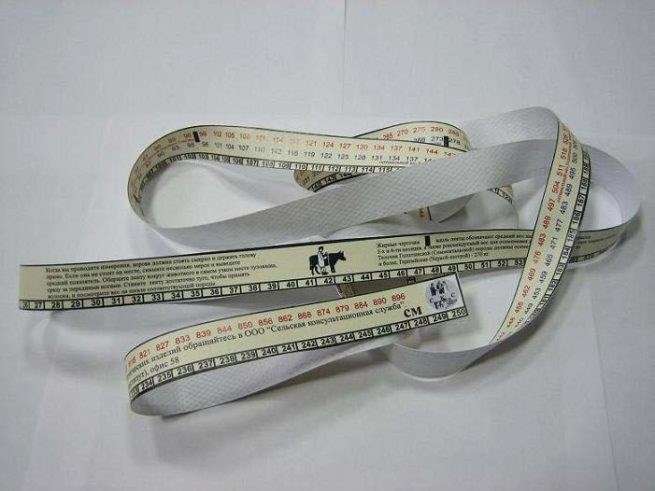

If it is high, then you need to add from 5 to 10% to the resulting value, and if it is low, then subtract the same percentages.
Slaughter weight
Slaughter weight (mass) in cattle (cattle) - the weight of the carcass without skin, head, viscera and lower legs.
Slaughter weight in sheep - the weight of the carcass without entrails and lower legs, and in pigs without bristles.
Have poultry slaughter weight depends on the characteristics of the post-slaughter processing of the carcass: it is the highest in an un-gutted bird, since it includes the mass of a bloodless and plucked carcass with fat, head, legs and internal organs; in a semi-gutted - the mass of a carcass with fat, but without intestines; with complete gutting, not only blood, feathers, fluff and intestines are removed; but also all internal organs, also the head to the second cervical vertebra, legs to the tarsal and wings to the elbow joint.
Conditions of detention
When organizing a barn for breeding cattle, one should take into account the importance of such aspects as: temperature conditions.
The room should not be colder than +10 ° C, if it is not cold keeping, for adult cattle and +15 ° C for calves; indoor humidity; good lighting; gas saturation; lack of noise, calm atmosphere.
The pasture is also worth taking care of. Its use makes the breeding process less costly, while the cow's body can fully develop, her movements are not constrained, she breathes fresh air, bathes in the sun.
The most beneficial effect of walking on pasture is for dairy and meat-and-dairy cows.
Slaughter exit
Slaughter exit - slaughter weight to live weight, expressed as a percentage. It depends on the type of animal, its breed characteristics, age, sex and fatness. Determined by which body parts are included in the slaughter weight.
The best indicators for the lethal yield and the quality of meat is provided by animals of specialized meat breeds. They have an increased maturity, well-developed and fine-fibred muscles with desirable fat layers, which give the meat juiciness and tenderness.
Slaughter of rabbits carried out in November-December at the end of the molt, when the hairline becomes thick and shiny. Pre-slaughter fasting exposure should be 12 hours with sufficient water supply. The most optimal age for slaughtering rabbits of all breeds is considered to be 110-130 days old, except for black-brown and gray giant. They are kept for up to 160 days.
At slaughterchickens, ducks, geese, turkeys the bird is taken by the head and the throat is cut 1.5-3 cm below the earlobe or ear (in a waterfowl). The duration of exsanguination is 1.5-3 minutes. Removing the feather and down cover from carcasses is very difficult.
The dependence of weight on the breed and the direction of productivity
The breeds of cows are divided by purpose into:
- meat;
- dairy;
- meat and dairy.
They vary in body constitution, weight, and performance.
Did you know? Cattle weight fluctuates constantly. Daily fluctuations range from 30 to 40 kg.
Dairy
The smallest representatives of cattle are dairy cows. Their weight data varies within 300 kg in females, 600 in bulls. They are distinguished by their neat physique and small dimensions. Babies are born with a weight of 20-30 kg.
Dairy heifers reach sexual maturity faster. You can reduce them already at 2 years of age.
Meat
Large-sized meat animals reach 500 kg at the age of one year. Babies are born with a weight of 40-50 kg. They are quickly fattened on dairy.
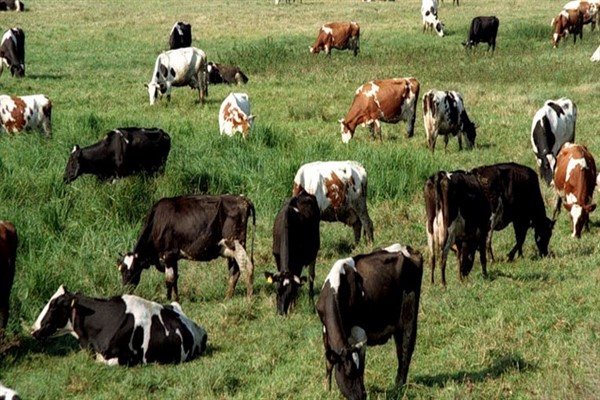

Heifers reach sexual maturity at 3 years of age. Animals are distinguished by high meat productivity. The meat is fatty, juicy, contains a maximum of animal protein.
Meat and dairy
These are universal animals of the combined direction. Male offspring are allowed to eat meat, and high-quality dairy products are obtained from cows. The weight of the female reaches 580-600 kg, of the male - 850 and more.
Calves are born with a weight of 30 kg. Depending on the breed, one of the qualities may be more pronounced. They grow faster and reach sexual maturity earlier than meat representatives.
Belonging to a particular breed plays a decisive role in how much a cow will weigh in adulthood. Information about the physique and dimensions of animals is inherited. By the type of productivity, the breeds of cows are divided into 3 groups:
- dairy;
- meat;
- meat and dairy.
Dairy cow
Cows of dairy breeds are characterized by a developed udder. They provide farmers with high milk yields throughout the entire lactation period. Their diet contains more green forage and hay.
Potatoes, which contribute to the growth of muscle and fat mass, are excluded from the menu of cows, since starchy substances cause blockage of the milk ducts. Dairy cows are not prone to rapid weight gain, as most of the nutrients are consumed in lactation. The average weight of a dairy cow is 360-500 kg.
Beef cows


Animals assigned to this group are distinguished by their ability to grow rapidly and increase body weight. Beef meat has a pleasant taste and tender structure. For quality fattening, farmers make up a certain diet for cattle, which includes:
- grain crops;
- beans;
- vegetables and root vegetables;
- hay and fresh herbs.
The weight of cattle reaches the maximum mark at the age of two. It makes no sense to feed the animals any longer, they are sent for slaughter. The weight of a beef cow is 650-800 kg. There are also champions in this category of cattle, for example, the Hereford breed, which is distinguished by a longer body. At the age of 1.5-2 years, the body weight of a female individual reaches 900 kg, and that of a bull - 1200-1400 kg.
Rural residents and owners of small farms prefer to breed universal cattle breeds for meat and dairy production. The average weight in such animals varies between 450-700 kg. They depend on the quality of feeding, livestock conditions and other factors.
Dairy breeds produce more fatty milk, but their meat is less nutritious. On average, cows weigh 500 kg and bulls 800 kg. The record holder for body weight is the Holstein breed. The cows are impressive in size with a weight of 800 kg, and the weight of bulls exceeds a ton.
Meat breeds gain weight very quickly. They have better quality meat due to their special muscle development. Cows can boast a weight of 550-800 kg, and bulls from 800 kg or more, often their weight exceeds a ton.
Meat and dairy breeds are all-rounders that provide the owner with milk and meat. Of course, they will produce less milk than dairy specimens and less meat compared to gobies. Cows weigh on average 550 kg and bulls about 900 kg.
Calf weight at birth
So, when processing poultry manually, labor costs for removing plumage make up 80% of all labor costs for processing carcasses. The quality of the carcass directly depends on the thoroughness of feather removal. If there are tears and scratches on the carcass, then the grade of such a carcass is reduced regardless of its fatness. When removing the feather cover, they also take into account the need to preserve the quality of the feather itself, especially down, which is a valuable raw material for the manufacture of various feather and down products.
Slaughter output of carcasses of chickens, geese, ducks and turkeys is 57 - 60%, and half-gutted 77 - 80%
Average slaughter yield of animals of different species
| Animal species | Lethal output% |
| Cattle | 55-66 |
| Sheeps | 44-52 |
| Pigs | 75-85 |
| Horses | 47-52 |
table - the average slaughter yield of animals
Indicators of slaughter and meat quality of gobies of different breeds (age 18 months)
| Breed | Simmental | Red motley | Kazakh white-headed | Red steppe | Black and motley | Kalmyk |
| 1 | 2 | 3 | 4 | 5 | 6 | 7 |
| Weight on the farm, kg | 522,6 | 487,1 | 464,8 | 451,1 | 462,7 | 419,6 |
| Weight at the meat processing plant, kg | 514,3 | 479,8 | 455,1 | 442,4 | 454,4 | 407,9 |
| Losses during transportation, kg | 8,3 | 7,3 | 9,7 | 8,7 | 8,3 | 11,7 |
| Carcass weight, kg | 278,6 | 253,5 | 253,5 | 235 | 236,4 | 222,3 |
| Carcass yield,% | 54,2 | 52,8 | 55,7 | 53,1 | 52 | 54,5 |
| Internal fat mass, kg | 12,1 | 10,7 | 13,2 | 11,5 | 8,7 | 12,3 |
| Internal fat yield,% | 4,3 | 4,2 | 5,2 | 4,9 | 3,7 | 5,6 |
| Slaughter weight, kg | 290,7 | 264,2 | 2bb, 7 | 246,5 | 245,2 | 234,7 |
| Lethal output,% | 56,5 | 55,1 | 58,6 | 55,7 | 54 | 57,5 |
| Internal fat yield in relation to the carcass | 4,3 | 4,2 | 5,2 | 4,9 | 3,7 | 5,6 |
table - indicators of slaughter and quality of meat of gobies of different breeds
Meat qualities of pigs of different breed combinations
| No. pp | Combinations of breeds | Before slaughter weight, kg | Muscular eye area, cm2 | % lard | % meat | % bones | Meat index | Lean index |
| 1 | T | 100,5 | 43,7 | 18,3 | 69,05 | 12,65 | 5,46 | 3,77 |
| 2 | KBhLn | 100 | 49,1 | 22,9 | 64,1 | 12,75 | 5,02 | 2,79 |
| 3 | (KBxLn) D | 100 | 45 | 24 | 64,3 | 11,65 | 5,5 | 2,68 |
| 4 | (КБхЛн) хПт | 100 | 51,1 | 28,25 | 60,85 | 10,75 | 5,66 | 2,15 |
| 5 | (КБхЛн) хТ | 101 | 50,5 | 25,5 | 64,6 | 9,9 | 6,5 | 2,53 |
| 6 | (KBx D) x Ln | 99,5 | 53,55 | 23 | 65,9 | 10,85 | 6 | 2,86 |
| 7 | (KBxD) xPt | 103 | 54,9 | 22,2 | 66,1 | 11,7 | 5,65 | 2,98 |
| 8 | (KBxD) хТ | 101,5 | 50,85 | 19,4 | 68,8 | 11,8 | 6,19 | 3,55 |
| Average | 100,8 | 49,8 | 23 | 65,3 | 11,6 | 5,6 | 2,84 | |
table meat qualities of pigs of different breed combinations
Slaughter yield of rabbit meat depending on age,%
| Breed | Age, days | |||
| 65 | 110 | 135 | 270 | |
| White giant | 46,2 | 53,2 | 59,8 | 60,0 |
| Gray giant | 45,4 | 53,4 | 59,2 | 59,1 |
| Black-brown | 46,4 | 52,3 | 57,5 | 57,9 |
| Silver | 51,5 | 54,9 | 58,6 | 53,1 |
| Vienna blue | 50,8 | 53,4 | 56,6 | 61,2 |
| Soviet chinchilla | 49,8 | 51,5 | 55,2 | 59,2 |
More articles on the topic:
- How much does a goose weigh
- How much does the lamb weigh
- How much does a Scottish cat weigh
- How much does a rhino weigh
Feeding scheme
The monthly weight of the calves is correct if the feed contains all the necessary nutrients. For animals to grow faster, the farmer needs to know the feeding habits.
First month
At the first stage of animal development, the main task of the owner is to strengthen the calf's immunity. Only dairy products are used for this. Within an hour after birth, he should receive valuable colostrum. It is distinguished from milk by its high protein content, which helps to strengthen the body of babies.
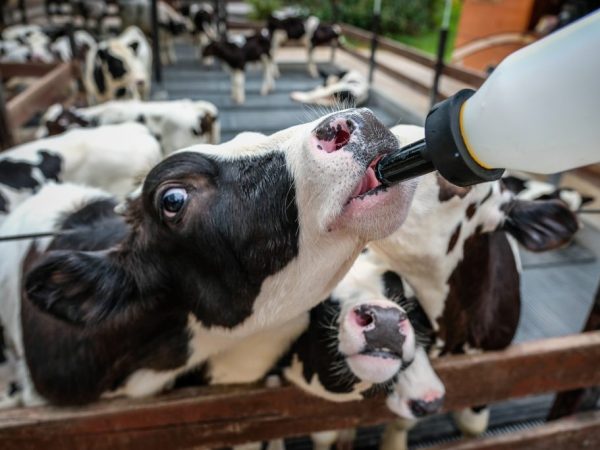

Mother's colostrum is the main diet for the baby immediately after calving.
A newborn bull is fed 5-6 times a day. This is done with nipple bottles. The hole in them must correspond to the age of the animals in order for the sucking reflex to develop correctly. Each individual is provided with a separate nipple. After application, it is disinfected. By the age of one month, the number of feedings is reduced to 3-4 times.
Milk is given steamed, and frozen is suitable. Its temperature should be 37-38 ° C. Milk from different cows is often mixed. This provides the calf with antibodies that will help build immunity. So that the bull gains weight well and does not vilify, vitamins are also added to the food - biovit or others.
Second month
They gradually switch to solid feed. Start with a starting compound feed. It contains products containing elements necessary for a growing organism. Such food is easily digested because it contains the following foods:
After the first week of feeding with compound feed, cicatricial digestion is improving, so hay is introduced into the diet. Every day the portions are increased by 150-200 g. Silage and haylage are added to the main feed.
After 60 days, the calves are given root crops, yogurt. Oatmeal jelly will provide them with vitamins A, D, E. Feeding is often done in small portions. The approximate amount of feed per day is 1.5-1.6 kg, including 1 kg of hay.
Third month
The goby's body is completely ready for the transition to solid food. It is worth providing it with plenty of protein. Milk is gradually being replaced by products with a high energy value. Soy-based concentrates work well for this. It is given in a dose of 2% as part of a compound feed, which also contains the following:
- peas - 30%;
- barley - 23%;
- corn - 20%;
- minerals and premix - 5%.


For optimal development, a calf needs a sufficient amount of succulent hay, therefore, from the end of 3 months, the baby is taught to self-graze on pastures
You will be able to prepare the food yourself, you just need to correctly calculate the proportions. This composition contributes to the rapid gain in mass of gobies. At this age, they are not selective in food, weigh about 100 kg, eat a lot and always leave the feeders empty. They are also given bran, fruits, vegetables.
From 4 months to half a year
During this period, for a good weight gain, it is worth giving the animals 1-2 kg of compound feed per day. In the warm season, they are grazed for 2-3 hours. It is important that there is water and a shaded area nearby. In cold weather, calves also need to walk. They are briefly released into the corral, which has a canopy. When grass is introduced into food, it is first dried. Then they gradually switch to fresh. This will help prevent indigestion. By six months, milk is completely removed from the diet.
From 6 months to a year
For a bull, this is a period of intense growth, muscle building. The musculoskeletal system is actively developing. Feeding is carried out 3 times a day. The ration should contain compound feed, hay, concentrates.
From 8 to 12 months, the feeding principle remains the same. For the bull to gain weight, it is worth increasing the amount of vitamins and nutrients. With the growth of the animal, the need for them also grows. If you do not provide it with the necessary elements, this will have a bad effect on the body of the bull, which will entail the following consequences:
- inactivity of the animal;
- stopping weight gain;
- weight loss;
- deterioration of immunity.
Sources:

